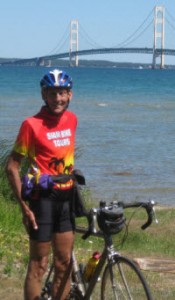State attracts visitors of motor-less bent
For seven days last summer, James Jeske, 66, bicycled along Michigan's western shore. The 500-mile-long trek took him from New Buffalo at the base of the Mitten to Mackinaw City at the tip of the Lower Peninsula.
Jeske did not cycle the peninsula alone, though. He was with 400 other cyclists on the Shoreline West Bike Tour who wound their way through towns like Ludington, Charlevoix and Harbor Springs -- averaging nearly 60 miles each day. Undaunted by the distances, the event planner and U.S. Air Force veteran from St. Louis, Mo., keeps coming back for more. In fact, Jeske has cycled his way around Michigan for the past 25 years.
“I come to Michigan,” he said, “because of the friendly atmosphere, the lakes, and the beautiful scenery. I love the wonderful farmers who have their fresh cherries and produce along the roadside. It has all the aspects to make bicycling and vacationing great.”
Michigan boasts more than 300 bike tours that criss-cross the state, said Rich Moeller, executive director of the League of Michigan Bicyclists, with approximately 45,000-50,000 cyclists who participate in them. Of the 300 tours offered, five are a week-long; of those, two sell out every year. The rest are at near capacity.
The booming bike tours means big business for Michigan and it may keep getting bigger.
Michigan tops trail rankings
Michigan is ranked No. 1 in the country for the largest rail-trail system with more than 2,400 miles of bike trails, according to Josh DeBruyn*, bicycle and pedestrian coordinator for the Michigan Department of Transportation. (Rail-Trails are the rights-of-way of old railroad lines converted to recreational use.)
Jim Sayer, executive director of Adventure Cycling, said within the next five years Michigan could become one of the top 5 bike tourist destinations in the country. One reason, he said, is that there is a major vitality to the (Michigan) bike movement: “When I visited, there were at least 20 bike co-ops springing up all over.”
He added, “Michigan is also one of the most assertive states in setting up designated bike routes.”
Michigan's rise among bicycling destinations may gain added momentum from legislative changes. Under existing law, cyclists must indicate a right turn with an upturned left arm. But House Bill 4782 would allow cyclists to extend his/her right arm horizontally to indicate a right turn. House Bill 4996 calls for a similar change. Nancy Krupiarz, executive director for Michigan Trails and Greenway Alliance, which, supports HB 4782, explained:
“If a cyclist sticks his/her arm straight out, the motorists are more aware that the cyclist is making a turn and the cyclist is able to notify the motorist what they are doing. That is always better for safety.”
But Michigan's primary advantage on cycling tourism may be what keeps James Jeske coming back year after year: the Great Lakes. “The Great Lakes provides many opportunities for tourists, from sand dunes to lighthouses to beaches to attractions to just the scenic beauty of these wonderful gems,” said Moeller of LMB. “Michigan has some wonderful roadways that are bicycle-friendly and offer great views of the lakes.”
Money in the spokes
According to a 2010 University of Wisconsin study, the Badger State enjoyed more than $920 million in economic benefits due to bicycle recreation and tourism. Of that total, the study credited almost $540 million to out-of-state cyclists alone.
“We have to be in that range,” argues Moeller of the bicyclists' league.
George Zimmermann of Travel Michigan, the state's tourism agency, said Michigan has not conducted a statistical review of bicycling tourism, though his agency has heard anecdotal reports of increased activity.
“Bicyclists rent cabins, hotel rooms, buy food, gas, souvenirs," said Moeller. "People spend money on bicycles and repairs. When you look at the bike industry and what it brings to the state, bicycling cuts across all lines because everyone can participate, young, old, the serious or the casual cyclist."
And potential cycling tourists are primed to spend.
The average household income of bicyclists, said Moeller, is roughly $125,000 a year. “They are people who have expendable income and when they come to tour, they want to spend, and they do," he noted.
“(The) local community is seeing dollars from folks coming in from somewhere else. I think that attracting out-of-town folks to your community to spend dollars is always a good thing, whether they come from another state, country or just another town in Michigan," Moeller said.
That's not exactly news to James Jeske. He plans to return to Michigan this summer to bike through the Upper Peninsula, meet up with old friends and enjoy the familiar terrain.
“We cannot do those kinds of bike rides here in Missouri,” he said. “They just don’t work. Nobody does biking better than Michigan.”
Dana Hollowell is the first holder of the Center for Michigan’s student fellowship. An award-winning journalist, she has experience in the broadcast and print media. Hollowell grew up in the Detroit metropolitan area.
* CORRECTION: Josh DeBruyn's name was misspelled in the original version of this story.
See what new members are saying about why they donated to Bridge Michigan:
- “In order for this information to be accurate and unbiased it must be underwritten by its readers, not by special interests.” - Larry S.
- “Not many other media sources report on the topics Bridge does.” - Susan B.
- “Your journalism is outstanding and rare these days.” - Mark S.
If you want to ensure the future of nonpartisan, nonprofit Michigan journalism, please become a member today. You, too, will be asked why you donated and maybe we'll feature your quote next time!


